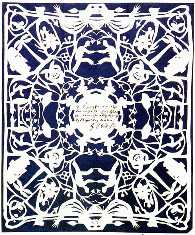
Hans Christian Andersen(2.4.1805 - 4.8.1875) There is some uncertainty as to exactly where in Odense Andersen was born. A tradition has pointed to a house in Hans Jensensstræde which now forms part of the museum. H.C. Andersens Hus. However, a little house in Munkemøllestræde is authentic.  The Family lived in a third of the house. The family lived here from 1807 to 1819. It was a house containing three single-room flats that were let out. Today, this is also a museum known as H.C. Andersens barndomshjem (H.C. Andersen’s Childhood Home).
 Andersen often amused himself by making fantastic paper cuts, not all of which were intended for children in the families he visited. Some of them, such as the one shown here, are large-scale inventive compositions, a whole fairy tale world in themselves or perhaps an indication of his most hidden dream world? Andersen gave this paper clip to a bazaar which the Students’ Union organised in Copenhagen for the benefit of the relatives of soldiers who fell in the Dano-German war of 1864. On the centre panel Andersen has written “This paper cut is rather dear/ priced at half a Rigsdaler/ But it is a whole cut-out fairy tale/ And your kind heart will pay”. In fact it sold for twice as much: 1 Rigsdaler (corresponding now to about £15.) [Back to top ]
Hans Christian Andersen was very of travelling. I [...] was received with infinite kindness and graciousness, a carriage from the Court fetched me, I lived at Hohenschwangau, at table was given a place by the King and Queen, and I went on a drive lasting several hours in the Austrian Tyrol in the company of the King himself; on that occasion no one asked to see my passport, which is such a bother to me; it was so lovely, and the King, who had read Das Märchen meines Lebens, spoke much of my childhood, my development and the various people with whom I had consorted. He was so understanding, and to me myself it was like a chapter in a fairy tale that I, the poor shoemaker's son, was traversing the mountains by the side of a king. The extremes in an incredible life appear here in sharp relief: the poor childhood home in the provincial town of Odense and the position as a European celebrity, courted by princes and kings. In an international perspective it might seem remarkable that the proletarian child Andersen, who in the course of his social progress had personally experienced the sharp divisions of the class society, made so much of his friendships in royal circles. Was he a snob? Or worse still, a traitor to his class? His friendships with princes and kings were established of course at a time when revolutions were sweeping through France and Germany, and when the bourgeois intelligentsia was in the process of gaining political power.
[Table of Contents][Top of page] Further information may be obtained from Royal Danish Ministry og Foreign Affairs |